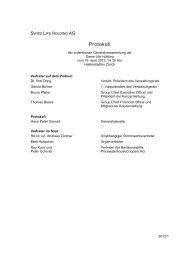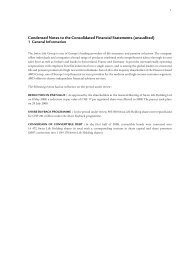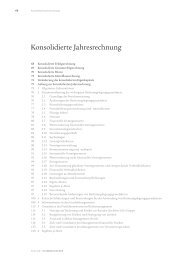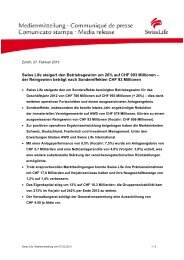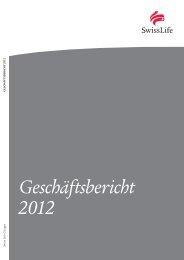Annual Report 2012 - Swiss Life
Annual Report 2012 - Swiss Life
Annual Report 2012 - Swiss Life
You also want an ePaper? Increase the reach of your titles
YUMPU automatically turns print PDFs into web optimized ePapers that Google loves.
49 Corporate Governance<br />
term planning and determined on the basis of the actual performance of individuals or teams (performance-linked<br />
payment) in relation to the objectives set and on the degree of achievement of the<br />
<strong>Swiss</strong> <strong>Life</strong> Group targets as reflected in its annual result (share in the company’s success). Quantitative<br />
and qualitative performance is assessed also on the basis of the competencies required for the function<br />
held, such as professional expertise, entrepreneurship, task fulfilment, cooperation and leadership.<br />
The percentage weighting between the individual and/or team performance and the share in the<br />
company’s success depends on the position and responsibilities of the function holder.<br />
The share in the company’s success is measured using quantitative Group targets (Key Performance<br />
Indicators, KPIs), which are defined in advance for the following three years as part of medium-term<br />
planning. The main KPIs, besides the key figures relating to annual profit, costs, business volume,<br />
investment return, return on equity and solvency, are the profitability of in-force and new business,<br />
margin performance and the share of non-traditional products in new business. In order to avoid<br />
conduct aimed at the short-term achievement of key indicators with a higher weighting, the individual<br />
KPIs are not mechanistically weighted in advance. Their individual weighting is determined at the<br />
end of each financial year by the Board of Directors on the basis of a proposal by the Nomination and<br />
Compensation Committee (NCC) taking all developments into account and consideration (discretionary<br />
decision).<br />
Personal performance based on the specified quantitative and qualitative objectives is assessed annually<br />
in the employee appraisal procedure implemented throughout the Group (Group Performance<br />
System, GPS). Two assessment elements/models are used for determining objectives and evaluating<br />
performance: The Group Objectives Model (GOM) relating to qualitative and quantitative objectives<br />
and the Group Competency Model (GCM) for measuring and assessing individual competencies and<br />
behaviour, incl. the compliance regulations.<br />
For persons responsible for risk management and risk control, the quantitative objectives are set in<br />
such a way that performance is not linked to the result of the monitored business unit, specific products<br />
or transactions.<br />
In order to be eligible for any variable compensation, a GPS target achievement of at least 80% is<br />
required.<br />
Permanent employment contracts in Switzerland contain notice periods of between three and twelve<br />
months, depending on position and seniority. All current employment contracts with members of the<br />
Corporate Executive Board specify a notice period of twelve months.<br />
PRACTICE AND PROCEDURE<br />
Pursuant to the Organisational Regulations, the Board of Directors as a whole is responsible for<br />
determining the level and make-up of compensation for its members, whereas the Nomination and<br />
Compensation Committee is responsible for putting forward appropriate proposals (for the internal<br />
organisation of the Board of Directors see “Internal Organisational Structure”, pages 37 to 40). The<br />
Board of Directors as a whole also establishes the guidelines for the company’s compensation policy.<br />
In doing so, it takes into consideration the compensation policies of other companies in the financial<br />
services industry, drawing its findings from publicly available information and studies by independent<br />
external experts. Comparable companies in the insurance sector in Switzerland used for the purposes of<br />
providing relevant information for the current compensation policy included Allianz, AXA, Baloise<br />
Insurance, <strong>Swiss</strong> Re and Zurich Insurance Group.<br />
<strong>Swiss</strong> <strong>Life</strong> – <strong>Annual</strong> <strong>Report</strong> <strong>2012</strong>



